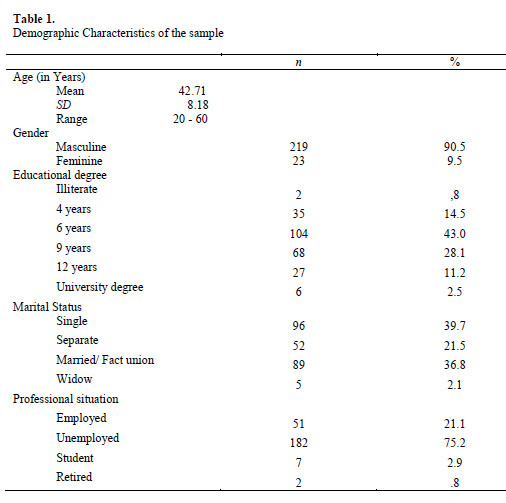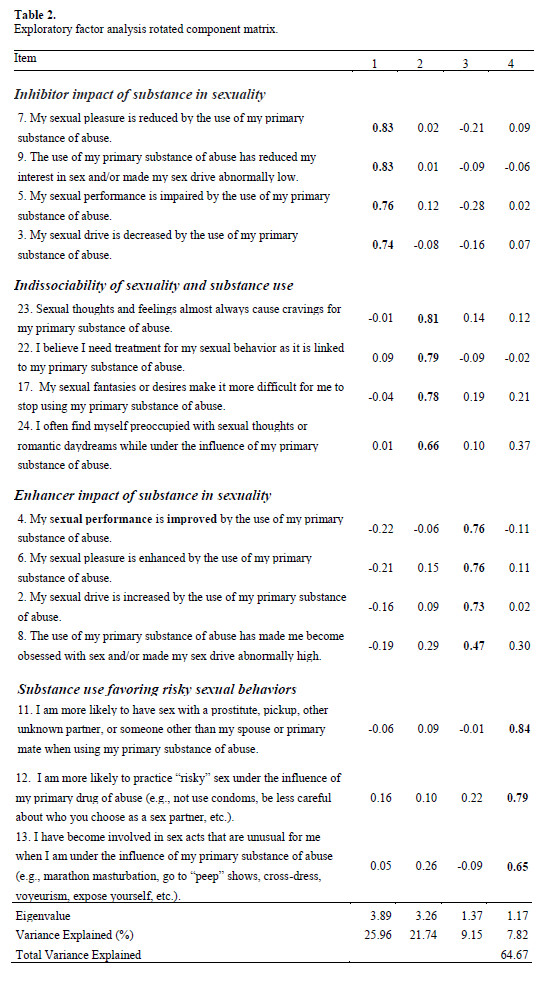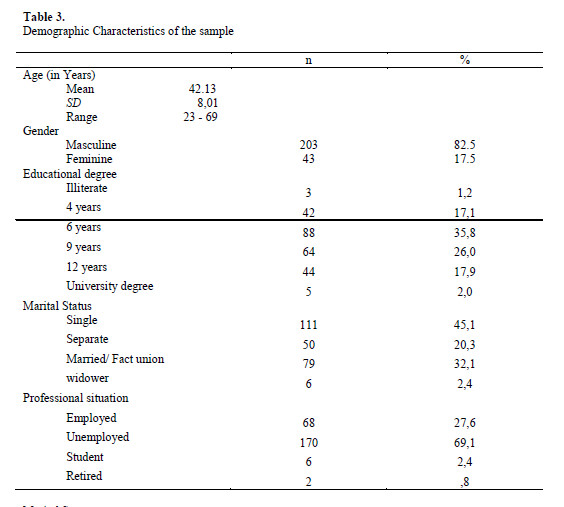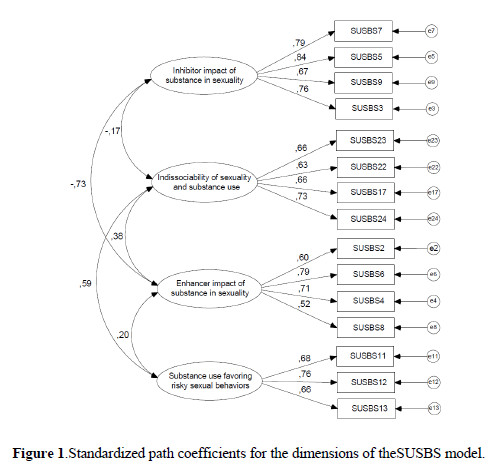Servicios Personalizados
Revista
Articulo
Indicadores
-
 Citado por SciELO
Citado por SciELO -
 Accesos
Accesos
Links relacionados
-
 Similares en
SciELO
Similares en
SciELO
Compartir
Psicologia, Saúde & Doenças
versión impresa ISSN 1645-0086
Psic., Saúde & Doenças vol.16 no.2 Lisboa set. 2015
https://doi.org/10.15309/15psd160207
Substance use and sexual behavior survey: a validation study
Questionário sobre o uso de substâncias e comportamento sexual: um estudo de validação
Sílvia Ribeiro1,2,Jorge Negreiros1, Joana Oliveira2, & Pedro Teixeira1
1 Faculdade de Psicologia e de Ciências da Educação da Universidade do Porto;
2 Instituto de Psicologia da Universidade Lusíada do Porto, Portugal
Endereço para Correspondência
ABSTRACT
Working with drug addicts we frequently face patients complains on sexual sphere .Literature doesn’t elucidate about the impact of cognitive factors. Aiming to enable a better understanding of the relation between psychoactive substance use and sexuality we proposed to adapt and validate the Substance Use and Sexual Behavior Survey (SUSBS) questionnaire. We studied 488 drug addict subjects, outpatients of the public drug addiction Portuguese centers. Exploratory factor analysis indicated a four-component structure we termed: Inhibitor impact of substance of abuse in sexuality,
Indissociability of sexuality and substance use, Enhancer impact of substance in sexuality, Substance use favoring risky sexual behaviors, explained approximately 65% of the total variance. The confirmatory factor analysis exhibited overall fits.
The results suggested that the Portuguese version of the SUSBS has adequate psychometric properties. We present a discussion in terms of the questionnaire utility, recommend its use for clinical and research purposes.
Key Words: Drug Addiction; Sexuality; Substance Use and Sexual Behavior Survey; Psychometric Properties
RESUMO
Desenvolvendo prática clínica com toxicodependentes, frequentemente nos deparamos com queixas na esfera sexual. A literatura não elucida relativamente ao impacto dos factores cognitivos, nesta dinâmica. Procurando alcançar uma melhor compreensão acerca da relação entre o uso das substâncias psicoactivas e a sexualidade propusemo-nos a adaptar e validar o questionário: Substance Use and Sexual Behavior Survey (SUSBS). Estudamos 488 sujeitos toxicodependentes, utentes dos Centros de Resposta Integrada para a toxicodependência, da Administração Regional de Saúde de Portugal. A análise exploratória resultou na indicação de uma estrutura em quatro factores, que designamos: Impacto do abuso de substâncias como inibidor da sexualidade, Indissociabilidade entre abuso de substâncias e sexualidade, Impacto do abuso de substâncias como potenciador da sexualidade e Uso de substâncias como favorecedor de comportamentos sexuais de risco. Esta estrutura explica aproximadamente 65% da variância total.
A análise confirmatória exibiu valores estatísticos satisfatórios. Os resultados sugerem que a versão portuguesa do SUSBS possuiu adequadas propriedades psicométricas. Apresentamos a discussão acerca da utilidade deste questionário, recomendando o seu uso na prática clínica e na investigação.
Palavras Chave: Toxicodependência; Sexualidade; Substance Use and Sexual Behavior Survey; Propriedades psicométricas.
Drug addiction is a complex phenomena and a very important issue in public health. Nowadays there is no society without drugs, although the use patterns modified with organization, cultural heritance, social and economic context. A widespread of scientific publications for the last decades illustrates the need of further understanding this reality.
Human sexuality also received an increased enthusiasm among professional helpers and investigators, still the empirical bases of some areas are limited (Lankveld, Everaerd, & Grotjohann, 2001). Underling the investigation on drug-sexuality stands different methodologies and theoretical constructs, also the double complex nature of the object on analysis
The studies on this area seem to group on: 1) Drug use and sexuality risk taking behavior, specially related to HIV infection (e.g., Brajevic-Gizdic & Pletikosa, 2008; Darke et al, 1990; Gunsaullus, 2006; Meandzija et al, 1994); 2) Sexual dysfunctions and drug/medication use (e.g., Lorga, 2000; Mintz, O’Hare, O’Brien & Golschmidt, 1974; NCASA, 1999; Smith et al, 1982), and the effects on drug users on treatment, specially on maintenance therapy with methadone and buprenorphine (e.g., Giacomuzzi, Khreis, Riemer, Garber & Ertl, 2009); 3) Drug use to improve sexual performance, and more recently specifically in party contexts (e.g., Calafat, Juan, Becoña, & Montecón, 2008; Mattison, Ross, Wolfson, Franklin, & HNRC Group, 2001), few studies investigated the performance sexual expectations on drug users (Bellis et al., 2008; Rawson, Washton, Domier, & Reiber, 2002).
Conceptual proposals on sexuality present expectations as an important determinant of sexual experience (McCarthy & Fucito, 2005; Nobre, 2006; Weisberg, Wincze, Brown, & Barlow, 2001). For instance, they argued that positive results expectations of drug impact on sexuality (sexual improvement) is associated with increased risk of drug experience and abuse (Katz, Fromme, & D’Amico, 2000). Most present expectancies as “structures in long-term memory that have impact on cognitive processes governing current and future consumption” (Jones, Corbin, &Fromme, 2001, p. 59).
The studies on drug users sexuality show high incidence of sexual dysfunction or non satisfying sexual experience (Johnson, Phelps, & Cottler, 2004; Leon & Wexler, 1973; Mintz et al., 1974; Palha & Esteves, 2002). Some authors wonder if a previous clinical condition won’t be behind this experience and have a stronger influence than the drug use contingences (La Pera, et al., 2008; Palha & Esteves, 2002). More recently, investigators try to understand to which point the drug use/abuse and sexuality associations are accidentals or the result of an intentional substance use in order to achieve some sexual goals (Bellis et al., 2008; Rawson et al.,2002).
In this article we present the adaptation and validation of the Sexual Behavior Survey (SUSBS) developed by Rawson, Washton, Domierand, and Reiber (2002). SUSBS in a Portuguese sample of heroin addicts, in maintenance therapy (methadone and buprenorphine). Two studies are presented: Study 1 presents an exploratory analysis determining the factor structure; Study 2 presents evidence of reliability and construct validity.
METHOD
Participants
Data collection involved a probabilistic sample. 488 participants (422 men – 86.5% and 66 women – 13.5%) completed a self-administered questionnaire after being informed about the aim of the study and their volunteer participation, assuring the anonymous and confidentiality of data. This subjects were recruited from outpatient drug addition public clinics, aiming a representative sample of Portuguese drug addicts in maintenance tretment with methadone (379 subjects - 77.7%) and buprenorphine (109 subjects – 22.3%), ages from 20 to 69 years old.The sample was randomly divided into two groups with approximatly 50% criteria for the validation analyses.The participants characterization and descriptive data is presented for each group.
Measures
The Substance Use and Sexual Behavior Survey (SUSBS) was developed by Rawson, Washton, Domierand, and Reiber (2002). It consists on a brief 25 questions self-report survey, assessing “the degree to which sexual thoughts, feelings and behaviors are associated with substance use among individuals who were diagnosed with (…) substance dependence disorders” (p. 104).“The questionnaire items were selected based on their clinical relevance and face validity but the psychometric properties of the instrument have not been formally established” (p.104). The SUSBS original version was translated and back-translated by two researches with high quality use of English and Portuguese (Vijver & Hambleton, 1996). We procedure to an experimental administration in the Addiction Treatment Public Clinic - Porto Oriental, using a focus group and individual context with a psychologist. This discussion lead to some corrections and the final version was obtained.
A demographics questionnaire regarding the participants’ age, gender, school years, ethnicity, relationship status, professional status, habitation condition, children and pharmacological treatment program was added. Additionally, a group of questions regarding psychoactive substance use was recorded. One section about sexual history and activity, and a last group of questions regarding addiction treatment history.
Procedures
Researches solicited access to drug addicts in treatment to the Directive Board of Instituto da Droga e da Toxicodependência, Instituto Público (Drug and Addiction Public Institut). After obtaining official and informed agreement to collect data, the coordinators of each drug center, randomly selected, were contact to organize interviews. Researches provided information regarding the purpose of the study accordingly with Helsinki Declaration; each set of questionnaires had the respective instructions and the participants provided informed consent and demographic information; confidentiality of the interview data was repeatedly emphasized.
Information was collected nationally by one of the authors and by clinical psychologists that were trained in the administration criteria.
The factor structure model of the SUSBS Portuguese version was obtained, in the study 1, using exploratory factor analysis (PASW Statistics software, v. 20, SPSS) procedures and tested, in study 2, by using Confirmatory Factor Analysis (AMOS Version 16.0).
RESULTS
STUDY 1
Participants
Participants in this study were 242 opiate users enrroled in a treatment program. As shown in Table 1, participants are mostly masculine (90,5%), age ranging from 20 to 60 years old (M= 42.71; SD = 8.18), with an educational degree mainly at the six years of schoolarity (43.0%) and unemployed (75.2%). In regard to the marital status, 39.7% were single, 36.8 % were married/ fact union, 21.5% were separate and only 2.1% were widow.

Exploratory factor analysis
The factor structure of the Portuguese version of the SUSBS, was determined conducting a principal components analysis, with varimax orthogonal rotation. The Kaiser-Meyer-Olkin (KMO) measure indicated the sampling adequacy for the analysis, KMO= 0.787, and Bartlett’s test of sphericity demonstrated the existence of large inter-items correlations, χ2=1370.255, p< 0.001.
Exploratory analysis was performed considering for each item the communality value and the factor loading. Items with lower communality values were removed until an acceptable and stable factorial structure was obtained that explained more than 60% of the total observed variance. Items that obtained high factor loadings in more than one factor were also removed. Theoretical appraisal of the latent constructs was also considered. The outcome of this analysis was a four-factor solution, which is presented in Table 2.

Due to the mentioned statistical criteria, 10 items (1, 10, 14, 15, 16, 18, 19, 20, 21, 25) were dropped from our version.
The first factor, presenting an eigenvalue of 3,89, contained four items that pertained to the Inhibitor impact of substance of abuse in sexuality, explained 25,96% of the observed variance.
The second factor obtained an eigenvalue of 3.26 and contained four items that reflect Indissociability of sexuality and substance use, explaining 21.74% of the of the observed variance.
The third factor, with an eigenvalue of 1.37, consisted of four items that reflect a Enhancer impact of substance in sexuality and explained 9.15% of the observed variance.
Finally, the fourth factor, presented an eigenvalue of 1.17, suggested the Substance use favoring risky sexual behaviors, and explained 7.82% of the observed variance.
The four factors explain 64.67% of the total observed variance.
STUDY 2
Participants
Participants in this study were 246 opiate users enrroled in a treatment program. Accordlingly to the Table 3, participants are mostly masculine (82.5%), with an age ranging to 23 to 69 years old (M= 42.13; SD = 8.01), with an educational degree mainly at the six years of schoolarity (35.5%) and unemployed (69.1%). In regard to the marital status, 45.1% were single, 32.1 % were married/ fact union, 20.3% were separate and only 2.4% were widow.

Confirmatory Factor Analysis
Input and model specification. Confirmatory factor analysis (AMOS, Version 16.0) was used for testing the construct validity of the Portuguese version of the SUSBS, specifying the same factor structure obtained in the study of exploratory factor analysis. The parameters of the models were estimated using maximum likelihood procedures.
Criteria for evaluating the model. The model was evaluated considering the significance of the path coefficients and overall fit. To evaluate the appropriateness of the models to the data, we considered various fit indices: a) the chi-square, with associated degrees of freedom and p value; b) the root mean square residual (RMR) with smaller values being the better; c) the goodness of fit index (GFI) producing values ranging from 0 to 1, with values exceeding of 0.90 indicating good fit; d) the comparative fit index (CFI) produces values ranging from 0 to 1, with values larger than .90 indicating good fit; e) the root mean square error of approximation (RMSEA) in values of .08 or lower indicate reasonable fit, being preferred values of 0.06 or below.
Table 4 presents the fit indexes of the two factor structures models and figure 1 gives the standardized path coefficients for the model.


All the factor loadings are reasonably high on the indicators and the substantive correlations among factors were designed according to the modification indices sustained by theoretical basis. All of the fit indexes suggested a reasonable adjustment of the models to the data.
Internal consistency
Cronbach’salfa statistics was conducted to determine the internal consistency of the dimensions, demonstrating good consistence in both samples (table 5)

DISCUSSION
Self-report measures have been proved to be an appropriate and important technique to assess several areas of human sexuality (e.g., Cappelleri, Siegel, Osterloh& Rosen, 2000).
The objective of the present study was to adapt and validate the Portuguese version of the SUSBS. Overall findings supported the psychometric adequacy of the questionnaire. Evidence suggests that it is internally consistent for four factors. In addition, the SUSBS appears to possess construct validity, confirming the ability of all four factors to differentiate between Inhibitor impact of substance in sexuality, Enhancer impact of substance in sexuality, Indissociability of sexuality and substance use and Substance use favoring risky sexual behaviors.
We are unaware of other measures that assess the degree to which sexual thoughts, feelings and behaviors are associated with substance use among individuals who were diagnosed with substance dependence disorders. The results found in our study are suggestive of a coherent conceptualization of the association of drug abuse and sexuality experience, mainly based on three aspects: the perception and/or expectation of a specific kind of drug use impact on sexuality (inhibitor and/or enhancer); using psychoactive substances as a condition of higher probability of sexual risk taking; a indissociability of sexuality and drug use (involvingin one is wishing the other),as the clinical practice frequently showed and some studies had suggested (Foxman, Aral & Holmes, 2006).
Clinicians often underestimate the prevalence of sexual dysfunction and the significance that sexual side effects of drug maintenance therapy and drug use may have on treatment compliance and outcomes. The SUSBS may be a useful tool for identifying those patients who are at greater risk of abandon treatment, enhance in sexual risk behavior, the individual with positive expectations about the impact of drug use in sexuality, and target them for a specific intervention and prevention programs. Therefore, the availability of a tool such as SUSBS will be very useful for surveying the degree of associating between sexuality and drug use, both in clinical practice and in research settings.
REFERENCES
Bellis, M., Hughes, K., Calafat, A., Juan, M., Ramon, A., Rodriguez, ..... Phillips-Howard, P. (2008). Sexual uses of alcohol and drugs and the associated health risks: A cross sectional study of young people in nine European cities. BMC Public Health, 8, 155-165.doi: 10.1186/1471-2458-8-155 [ Links ]
Brajevic-Gizdic, I., & Pletikosa, M. (2008). Sexual behavior of heroin addicts in treatment. Heroin Addiction and Related Clinical Problems, 10, 5-12. [ Links ]
Calafat, A., Juan, M., Becoña, E., & Montecón, A. (2008). Qué drogas se prefieren para las relacionessexualesen contextos recreativos. Adicciones, 20, 37-48. [ Links ]
Cappelleri, J., Siegel, R., Osterloh, I., & Rosen, R. (2000). Relationship between patient self-assessment of erectile function and the erectile function domain of the International Index of Erectile Function. Urology, 56, 477-481. doi: 10.1016/S0090-4295(00)00697-x. [ Links ]
Darke, S. Hall, W., & Carless, J. (1990). Drug use, injecting practices and sexual behavior of opioid users in Sydney, Australia. British Journal of Addiction, 85, 1603-1609. doi: 10.1111/j.1360-0443.1990.tb01649.x. [ Links ]
Foxman, B., Aral, S., & Holmes, K. (2006). Common use in the general population of sexual enrichment aids and drugs to enhance sexual experience. Sexually Transmitted Diseases, 33, 156-162. doi: 10.1097/01.olq.0000187210.53010.10 [ Links ]
Giacomuzzi, S., Khreis, A., Riemer, Y., Garber, K., & Ertl, M. (2009). Buprenorphine and methadone maintenance treatment – Sexual behavior and dysfunction prevalence. Letters in Drug Design & Discovery, 6, 13. doi: 10.2174/157018009787158580
Gunsaullus, J. (2006). The politics of AIDS. Sexual pleasure and danger.In S. Seidman, N. Fischer & C. Meeks (Eds.), Handbook of the new sexuality studies, (pp.469-476). Oxon, UK: Routledge [ Links ]
Jones, B., Corbin, W., & Fromme, K. (2001).Conceptualizing addiction. A review of expectancy theory and alcohol consumption. Addiction, 96, 57-72.doi: 10.1046/j.1360-0443.2001.961575.x [ Links ]
Johnson, D., Phelps, L., & Cottler, B. (2004).The association of sexual dysfunction and substance use among a community epidemiological sample. Archives of Sexual Behavior, 33, 55-63. doi: 10.1023/B: ASEB.0000007462.97961.5a [ Links ]
Katz, E., Fromme, K., & D’Amico, E. (2000). Effects of outcome expectancies and personality on young adults’ illicit drug use, heavy drinking, and risky sexual behavior. Cognitive Therapy and Research, 24, 1-22. doi: 10.1023/A: 1005460107337
La Pera, G., Garderi, A., Marianantoni, Z., Peris, F., Lentini, M., & Taggi, F. (2008). Sexual dysfunction prior to first drug use among former drug addicts and its possible causal meaning on drug addiction: preliminary results. The Journal of Sexual Medicine, 5, 164-172. doi: 10.1111/j.1743-6109.2007.00571.x [ Links ]
Lankveld, J., Everaerd, W., & Grotjohann, Y. (2001). Cognitive-behavioral bibliotherapy for sexual dysfunctions in heterosexual couples: A randomized waiting-list controlled clinical trial in the Netherlands. The Journal of Sex Research, 38, 51-67. doi: 10.1080/00224490109552070 [ Links ]
Leon, G., & Wexler, H. (1973). Heroin addiction: its relation to sexual behavior and sexual experience. Journal of Abnormal Psychology, 81, 36-38. doi: 10.1037/h0034009 [ Links ]
Lorga, P. (2000). Estudo exploratório das problemáticas sexuais numa população toxicodependente. Dissertação de Mestrado, Instituto de Educação e Psicologia: Universidade do Minho (unpublished).
McCarthy, B., & Fucito, L. (2005).Integrating medication, realistic expectations, and therapeutic interventions in the treatment of male sexual dysfunction.Journal of Sex & Marital Therapy, 31, 319-328. doi: 10.1080/00926230590950226 [ Links ]
Mattison, A., Ross, M., Wolfson, T., Franklin, D., & HNRC Group (2001). Circuit party attendance, club drug use, and unsafe sex in gay men. Journal of Substance Abuse, 13, 119-126. doi: 10.1016/S0899-3289(01)00060-8 [ Links ]
Meandzija, B., O'Connor, P.G., Fitzgerald, B., Rounsaville, B.J., & Kosten, T.R. (1994). HIV infection and cocaine use in methadone maintained and untreated intravenous drug users. Drug and Alcohol Dependence, 36, 109-113. doi: 10.1016/0376-8716(94)90092-2 [ Links ]
Mintz, J., O’Hare, K., O’Brien, C., & Goldschmidt, J. (1974). Sexual problems of heroin addicts. Archives of General Psychiatry, 31, 700-703. doi: 10.1001/archpsyc.1974.01760170088014
National Center on Addiction and Substance Abuse (1999). Dangerous Liaisons: substance abuse and sex. New York, NY: Author. [ Links ]
Nobre, P. (2006). Disfunções sexuais. Teoria, investigação e tratamento. Lisboa, PT: Climepsi Editores. [ Links ]
Palha, P., & Esteves, M. (2002).A study of the sexuality of opiate addicts. Journal of Sex and Marital Therapy, 28, 427-437. doi: 10.1080/00926230290001547 [ Links ]
Rawson, R., Washton, A., Domier, C., & Reiber, C. (2002). Drugs and sexual effects: role of drug type and gender. Journal of Substance Abuse Treatment, 22, 103-108. doi: 10.1016/S0740-5472(01)00215-X [ Links ]
Smith, D., Moser, C., Wesson, D., Apter, M., Buxton, M., Davison, J., ....Buffum, J. (1982).Clinical guide to the diagnoses and treatment of heroin-related sexual dysfunction. Journal of Psychoactive Drugs, 14, 91-99.doi: 10.1080/02791072.1982.10471916 [ Links ]
Vijver, F., & Hambleton, R. (1996). Translating tests: some practical guidelines. European Psychologist, 1, 89-99.doi: 10.1027/1016-9040.1.2.89 [ Links ]
Weisberg, R., Wincze, J., Brown, T., & Barlow, D. (2001). Causal attributions and male sexual arousal: the impact of attributions for a bogus erectile difficulty on sexual arousal, cognitions and affect. Journal of Abnormal Psychology, 110, 324-334. doi: 10.1037/0021-843X.110.2.324 [ Links ]
Endereço para Correspondência
Faculdade de Psicologia e de Ciências da Educação da Universidade do Porto, Rua Alfredo Allen, 4200-135 Porto, Portugal. Telef.: 00351226079700. Fax: 00351226079725. E-mail:silviarocharibeiro@gmail.com
Recebido em 06 de Outubro de 2014/ Aceite em 15 de Fevereiro de 2015














